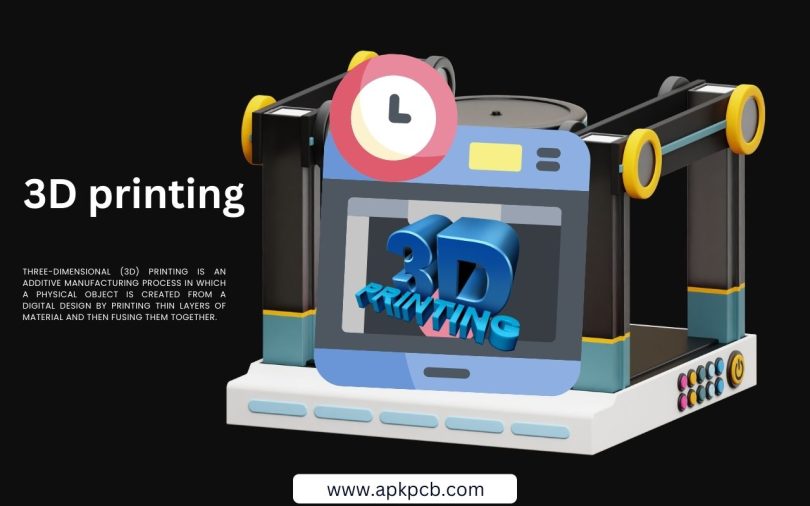Three-dimensional or 3D printing may alternatively be referred to as additive manufacturing whereby computer-designed items are produced in layers.
Unlike subtractive manufacturing techniques that carve or cut down from large solid blocks, additive manufacturing processes involve adding layers of materials to build or create a 3D component. As a result, 3D printing minimizes material and resources wasted on production.
History of 3D Printing:
The first manufacturing device for three dimensional printing was designed by Hideo Kodama, a scientist from Nagoya Municipal Industrial Research Institute, who invented two additive techniques for the production of three-dimensional objects.
This could be a history of how 3D printing was started by Ralph Bakers when he created some decorative articles in 1920. Developments included the addition of stereolithography (by 1984) and conclusion of Hideo Kodama’s work on laser-cured resin rapid prototyping by 1981. The first 3D printer was developed by Chuck Hull of 3D systems through the use of the stereolithography process in 1987
Other expensive 3D printing systems were introduced in the 1990s through early 2000s, but their cost drastically fell when patents expired in 2009 leading to further adoption by the general public.
Steps in Preparing 3D Models for Manufacturing:
In operation, 3D printing involves building a 3D model that may be generated from scratch or sourced from a 3D library.
There are numerous software programs that support this task. In fact, one of them is Tinkercad considered to be a great option (especially for beginners). One can use Tinkercad for free and it has tutorials for beginners who may also export the models into printable formats.
The next step involves making the file ready for the 3D printer called “slicing”. It consists of cutting the three dimensional model into many layers using specific slicing software.
Upon cutting a file, it becomes ready to be printed by three dimensional machine. However, these files can be transferred to the printer via a USB, SD, or wireless LAN connection. Finally, it is subjected to a 3D printing procedure which builds the sliced file with each passing layer.
Additionally manufacturing has been universally accepted and more enterprises have begun integrating it in their supply chain. Once appropriate primarily for prototyping and small scale production, 3D printing is advancing towards a full-scale manufacturing process.
The market focus of 3D printing today is mainly on industrial activities. According to Acumen Research and Consulting, the market for 3D printing will be worth $41 billion in 2026. 3D printing technology is projected to revolutionize virtually all major industries as time goes by.
Rapid Prototyping & Rapid Manufacturing:
Rapid prototyping is a practice in which companies have used the 3D printers since the late seventies to produce prototypes.
The rationale for employing 3D printers in rapid prototyping is succinct; it is fast and affordable. It just takes days, unlike the traditional method which would have spanned several weeks including conceptualization, creation of a 3D model and molding of a prototype. These iterations are usually easier and cheaper compared with having expensive molds or tools.
Also, there is rapid manufacturing which is a new manufacturing method in which companies make use of 3D printers for short run or small batch, and custom manufacture.
3D Printing Technologies:
Generically classified, there exist three categories of 3D printing methodologies: sintering, fusion, and stereolithography.
Sintering is a process that does not involve total melting of the material and creates fine products. Direct metal laser sintering uses metal powder, while selective laser sintering works with thermoplastic powders.
This includes powder bed fusion, electron beam melting, and direct energy deposition, using lasers, electric arcs, or electron beams to fuse materials.
Parts are created through photopolymerization in stereolithography. In this case, specific light sources are used that penetrate certain layers and cure or harden thin sections of the object.
Duration of 3D Printing:
The duration of time needed to conduct 3D printing depends on parameters like size of the part, the print setting and quality expected. Printing time may be a few minutes to many hours or even days depending on speed, resolution and volume of material used.
Advantages of 3D Printing:
Tailored, Cost-Effective Complex Geometries:
It allows for the development of individual geometrical elements at no extra expense; therefore, this makes it possible that it is even less costly than subtractive producing.
Economical Start-up Costs:
There being no requirement for molds, their associated manufacturing costs are normally minimal. Material use, build time and post-processing also determines part costs.
Complete Customization:
Modifications for their product, which is computer-aided design based, are easy if cost of the product will not be affected.
Ideal for Rapid Prototyping:
In line with this, 3D printing proves well-fitting with smaller batches and internal manufacturing, which facilitates accelerated prototyping with no dependence on the supply chain.
Creation of Parts with Specific Properties:
Commonly used materials like plastics and metals have specialized materials that can either be highly heat resistant or water repellent in some cases.
Disadvantages of 3D Printing:
Potential Lower Strength:
In contrast, even with good mechanical characteristics for some metal parts, many components made using this approach are likely to have a lower strength that varies between 10% and 50%.
Increased Costs for High-Volume:
Economies of scale are limited concerning 3D printing and therefore production runs are no more cost effective than the traditional way. Based on estimates, it is not efficient to use this type of production after 100 identical items if alternate methods are available.
Limitations in Accuracy:
The kind of equipment that is used for printing determines the quality of printed portions. Therefore, it is important to note that desktop printers might have smaller tolerance levels, resulting in minor differences from the designs provided. Therefore, these discrepancies might call for additional post-processing.
Post-processing Requirements:
Most of these 3D printed parts demand post-processing like sanding, polishing, extraction of support struts and heating to have some particular material properties such as final surface treatments or machining.
Conclusion:
3D printing has evolved from an obscure prototyping tool to a revolutionary revolution that will transform industries. It is a good choice for future manufacturing due to its ability to create intricate shapes, fast customization and reduction of wastage. However, despite limitations like strength and cost the ceaseless march of innovation shall find ways of surmounting these obstacles. With the increasing sophistication and affordability of 3D printers, we are at the very brink of a world where everything imaginable can be given flesh, layer by layer.








